Sign up for one of our email newsletters.
Updated 17 minutes ago
They look like anything but computer whizzes, but the kindergarten students at Newlonsburg Elementary School might just surprise you.
These tots are learning the fundamentals of computer programming as they work in groups to come up with instructions to move a “BeeBot” around the classroom.
The yellow and black bee-like robots were designed to expose youngsters to computer coding when they're just beginning to learn to read. Franklin Regional sent the district's kindergarten teachers to workshops last year to introduce them to BeeBots.
The robots can move, turn, blink and beep upon command and can respond to a sequence of up to 40 commands.
Andrew Leviski, principal at Franklin Regional Middle School, said the new kindergarten program is part of an effort to fully integrate coding into district schools. Although there are high school electives and a variety of initiatives at the middle school to identify students with a flair for STEM — Science, Technology, Engineering and Math — the district has a way to go to meet its goal of exposing every student to these skills.
“We'll probably be at 100 percent within the next five years,” Leviski predicted.
It's not uncommon to hear of programs in the making in Pennsylvania.
Experts said coding skills are in demand. They are fundamental to the work of web developers, technicians who design and create websites.
The U.S. Bureau of Labor Statistics is projecting a 27 percent growth rate in the demand for web developers through 2024, or about 39,500 new jobs that in 2015 had a median salary of $64,970 a year.
Public schools bought into the digital world more than three decades ago, teaching keyboarding and mouse skills to elementary students through programs like “Oregon Trail,” but there is no required curriculum for computer science.
Last year, the state finally allotted computer science a place in schools, ruling that a high school computer science course could be counted as a credit toward graduation in science or math.
Tammy Pirmann, a computer science teacher in Eastern Pennsylvania and board member of the national Association of Computer Science Teachers, said she was surprised when a recent survey of the state's schools found that “about 50 percent offer computer science in some form,” and most high schools offer electives.
Pirmann said that's progress, but it still leaves out too many students. Her organization is advocating national standards for computer science in K-12 schools.
“Pretty much every English-speaking country in the world has computer science as a requirement except the USA. There are no reasons not to do it,” she said.
Pirmann said teachers can integrate computer science into existing curricula.
“Bootstrap is a program that builds computer science inside the algebra curriculum. We had one teacher who was teaching algebra Monday through Thursday and then Bootstrap on Friday as a reward to the students. They loved it,” she said.
A roster of local computer science classes that reflects extensive enrollment in middle school computer technology classes in Greensburg Salem, Hempfield Area, Mt. Pleasant Area, Derry Area and Burrell suggests schools are slowly moving in that direction.
But like the kindergarten teachers at Newlonsburg, many believe coding can be seamlessly integrated into schools if students start earlier.
Gregory Egnor, principal at Stewart Elementary School in the Burrell School District, said computer science is a fact of life for all fourth- and fifth-graders at the upper level elementary school in Lower Burrell, which was reorganized as a STEM school five years ago.
Stewart took advantage of the growing interest in robotics to introduce elementary students to writing computer code.
“Here we have robotics, and every fifth-grader takes that. We've been doing that for five years. They learn coding by programming these robots. They learn writing a program to tell the robot to do something,” Egnor said.
He said Burrell isn't trying to churn out computer scientists and engineers, but rather to promote the kind of critical thinking and creativity that will be important as students move through school.
“Coding is like a foreign language. It's like a different way of thinking. We're teaching critical thinking,” he said.
Students work together in teams to tackle problems. “Our formula isn't for a few. We want all of our students to have these opportunities,” Egnor said.
Like Leviski, he sees it as a work in progress. He believes it will succeed because of what it requires of students.
“Everything in education happens slowly. We are bound by standards developed by politicians. But this is important work in the 21st century,” he said. “It's not about teaching content. It's about critical thinking, problem solving, working with others and a different way of thinking. It's about creativity.”
Debra Erdley is a Tribune-Review staff writer. Reach her at 412-320-7996 or derdley@tribweb.com.
Our editors found this article on this site using Google and regenerated it for our readers.






